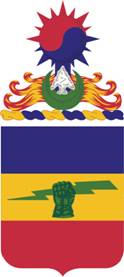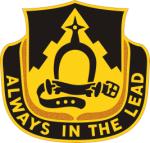
The 34th Infantry Division is an infantry division of the United States Army, part of the National Guard, that participated in World War I, World War II and multiple current conflicts. It was the first American division deployed to Europe in World War II, where it fought with great distinction in the Italian Campaign.

The 1st Armored Brigade Combat Team, 1st Cavalry Division is a cavalry unit of the United States Army based in Fort Hood, Texas.

The 32nd Infantry Brigade Combat Team is an infantry brigade combat team in the United States Army National Guard. It was formed from the inactivated 32nd Infantry Division in 1967. It is the largest unit in the Wisconsin National Guard.

The Wisconsin Army National Guard ("Guard") has dual state and federal roles, and is jointly funded and maintained by both governments. Its federal mission is to provide trained units to the United States Army in time of war or national emergency. Its state mission is to help civil authorities protect life and property and preserve peace, order, and public safety in times of natural or human-caused emergencies. The governor, who is the commander in chief of the Guard when it is not activated for federal service, appoints the adjutant general who directs the Wisconsin Department of Military Affairs, of which the Guard is a part. Members of the National Guard are typically part-time soldiers who attend unit drills one weekend per month and serve a two-week annual tour of active duty. All officers and enlisted personnel must meet the same physical, education, and other eligibility requirements as members of the active-duty services.

The 3rd Brigade Combat Team, 1st Cavalry Division is a combined arms armored brigade of the 1st Cavalry Division based in Fort Hood, Texas. Its major equipment includes M1A2SEP Tanks, M2A3 & M3A3 Bradley infantry fighting vehicles, M109A6 Paladin howitzers, and M1114 up-armored Humvees.

The 73rd Cavalry Regiment is a Cavalry Regiment in the United States Army, first formed in 1941. The three squadrons of the 73rd Cavalry Regiment provide reconnaissance, surveillance, and target acquisition (RSTA) to the Brigade Combat Teams of the 82nd Airborne Division. 3rd Squadron is assigned to 1st Brigade, 1st Squadron is assigned to 2nd Brigade, and 5th Squadron is assigned to 3rd Brigade.

The 3rd Brigade Combat Team, 10th Mountain Division is an infantry brigade combat team of the United States Army based at Fort Polk, Louisiana. Since its activation in 2004, the brigade has deployed four times to Afghanistan in support of Operation Enduring Freedom. In 2014, the brigade inactivated at Fort Drum, NY, and its infantry battalions were reassigned to other brigades while its special troops battalion, field artillery battalion, brigade support battalion and cavalry squadron were inactivated. The brigade reactivated at Fort Polk, LA in 2015 by reflagging the assets of the 4th Brigade Combat Team, 10th Mountain Division, which was inactivated. The infantry, cavalry and field artillery battalions of the 4th Brigade were reassigned to the 3rd Brigade. The brigade deployed to Iraq in 2017 in support of Operation Inherent Resolve. Recently, the brigade deployed to the Southwest Border in 2019 in support of Operation Faithful Patriot.

The 67th Maneuver Enhancement Brigade is a maneuver enhancement brigade (MEB) of the Nebraska Army National Guard. It derives its lineage from the 67th Infantry Brigade (Mechanized), previously a component of the 35th Infantry Division (Mechanized). The brigade has also been organized as an area support group from 2003–2008, and as a battlefield surveillance brigade from 2008–2016.

The 33rd Armor Regiment was an armored regiment in the United States Army first formed in 1941. In 2005, the 33rd Armor was redesignated 33rd Cavalry Regiment. The 1st Squadron, 33rd Cavalry Regiment, a part of the 3rd Brigade Combat Team, 101st Airborne Division, carries on the lineage of 33rd Armor Regiment.

The 34th Armor Regiment is an armored regiment of the United States Army formed in 1941.

The 1st Battalion, 107th Cavalry Regiment was a unit of the Ohio Army National Guard, with troops in multiple locations throughout northeastern Ohio and has served in the United States of America's major wars and conflicts since 1898 until its inactivation on 31 August 2007.

The 102nd Cavalry Regiment is a regiment of the United States Army first established in 1913 and which saw service in World War II.

The 299th Cavalry Regiment, formerly the 299th Infantry Regiment, nicknamed "The Koa Squadron", is a unit of the Hawaii Army National Guard. It was established in 1923 from the old 2nd Hawaiian Infantry Regiment, and it served during World War II as part of the 24th Infantry Division. The name "Koa" comes from the Hawaiian word for "Warrior", and is currently headquartered in Hilo, Hawaii. The 1st and 2nd Battalions, 299th Infantry were federally activated in 1968 to support the United States Army Pacific during the Vietnam War. More recently 2nd Battalion, 299th Infantry Regiment deployed to Iraq and again after being re-flagged in 2007 as 1st Squadron, 299th Cavalry Regiment.
The 126th Field Artillery Regiment was a regiment in the United States Army National Guard.

The 1st Squadron, 180th Cavalry Regiment is a formation of the United States Army, headquartered in McAlester, Oklahoma. It is a part of the 45th Infantry Brigade Combat Team, Oklahoma Army National Guard and is one of the oldest units in the brigade.

The 134th Cavalry Regiment is a cavalry regiment in the Nebraska Army National Guard. By extension, it is a member of the United States Army National Guard, and as a currently federally-recognized unit, also a member of the National Guard of the United States.

The 1st Squadron, 1st Cavalry Regiment is the BCT cavalry squadron assigned to the 2nd Brigade Combat Team, 1st Armored Division. Carrying the lineage of Company A, United States Regiment of Dragoons, the squadron has served in the Mexican War, Civil War, various Indian Wars, the Spanish–American War, the Philippine Insurrection, World War II, Vietnam, and the Global War on Terrorism.

The 303rd Cavalry Regiment is a United States cavalry regiment, currently represented in the Washington Army National Guard by the 1st Squadron, 303rd Cavalry, headquartered at Vancouver, Washington, part of the 96th Troop Command. It incorporates the lineage of the 303rd Cavalry, 303rd Armor, and 803rd Armor Regiments of the Washington Army National Guard.
The 122nd Field Artillery Regiment is a field artillery regiment of the Illinois Army National Guard. The regiment's 2nd Battalion is the cannon battalion assigned to the 33rd Infantry Brigade Combat Team.
The 120th Field Artillery Regiment is a field artillery regiment of the Wisconsin Army National Guard.


















